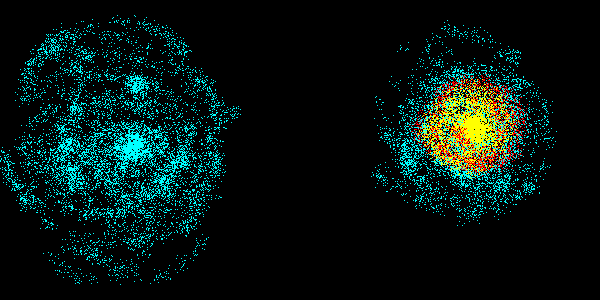Structure of the Jupiter
- Low density (1300 kg/m3) implies that Jupiter is
mostly made of gas.
- Most of the universe is made of H and He, so those are the likely
candidates.
- Spectroscopy (looking at the light) by space probes gives for
the outer layers of Jupiter
- 86% H
- 14% He
- a little CH4, NH3, H2O ...
- Deep inside expect more He, less H because He is heavier.
- Measurement of infrared light emitted by Jupiter shows that
it emits twice as much energy as it gets from sun.
- This means that it is hot inside and is slowly cooling.
- It should be hot, because when the gas was compressed by
gravity it would have been heated.

- Presumably it got hot deep inside Jupiter, but not hot
enough to make it a star.
- The mass of Jupiter is about 0.001 Msun.
- But for nuclear fusion to start, a mass greater than about 0.1 Msun is needed.
- It takes a long time for something so big to cool.
- So deep inside it should be very hot and very dense.
Models give:
- pressure at center roughly 80 million atmospheres.
- temperature at center roughly 25,000 K.
- (cf surface of Sun, about 6000 K)
- Very hot and very dense hydrogen conducts electricity.
(It's "metallic")
- Jupiter has a big magnetic field.
- Recall ingredients for magnetic field (eg. on Earth)
- Heat being transfered from center.
- Fluid layer that transfers the heat by conduction.
- Rotation to bend the fluid motion.
- Fluid is electrical conductor.
- Jupiter fits all of these.
- Also, planetary scientists deduce that Jupiter has a rocky core
based on its observed oblateness.
- This is sensible from the point of view of Jupiter's evolution.
The rocky core could form first, then attract the gas.

Model for Jupiter's interior.
Note that there is no "surface of Jupiter."
ASTR 121 Home
Davison E. Soper, Institute of Theoretical Science,
University of Oregon, Eugene OR 97403 USA
soper@bovine.uoregon.edu

